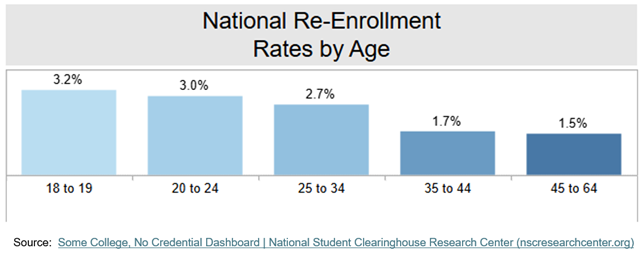How Can You Get Students Who Stopped-Out to Re-Enroll?
Dave Emsweller, High Impact Practitioners LLC
Most higher education institutions consistently focus their efforts on finding and enrolling new students. While this is important, it often consumes the time, attention, and resources of the institution in ways that can leave current students feeling like an afterthought. As a result, retention/completion rates suffer and the number of students who choose to stop out grows. A recent report by the National Student Clearinghouse Research Center (https://nscresearchcenter.org/some-college-no-credential/) indicates that the percentage of students who stop out continues to grow (36.8 million at the end of 2022; up 2.9 percent from the previous year). Additionally, the re-enrollment rates of stop outs have a concerning range of 1.5% to 3.2% nationally across age groups.
This is clearly a group of students that deserves more attention and focus. What if an institution could increase their re-enrollment of stop outs by five, ten, or twenty percent? What could that mean for retention/completion rates? How could that help with the overall budget? Increasing re-enrollment rates needs to have the same importance as attracting and enrolling new students.
So, what strategies can institutions use to get students who stopped out to re-enroll?
High Impact Practitioners believes that the following approaches are important to consider:
Streamline and Promote the Re-enrollment Process
Remove unnecessary barriers by streamlining the re-application process, waiving fees, or offering “re-enrollment days” with immediate support for paperwork and course registration.
Create a specific advising role focused on helping former students navigate the process of returning to school.
Launch marketing efforts that are specifically designed to engage former students. Include incentives like waived application fees or free course credits.
Organize welcome-back events for returning students to help them reconnect and ease their transition back.
Leverage Personal Contact
Reach out via personalized emails, calls, or texts periodically for a year following when they stopped out.
Use data to identify students who left but were close to completing their degrees and reach out with tailored messaging that emphasizes how close they are to graduating.
Use digital marketing strategies, including social media ads, that target students who previously left. These campaigns could highlight alumni who returned to finish and succeeded.
Offer Flexible Learning Options
Offer flexible scheduling through online or hybrid courses to make it easier for students to balance work, family, and education.
Introduce certificate programs or smaller credentials that can later count towards a full degree.
Create accelerated course formats (condensed semesters or summer classes) that allow students to complete credits more quickly.
Design programs specifically for returning students, allowing them to finish with flexible course loads or a reduced number of credits.
Provide Financial Incentives and Support
Provide special scholarships, grants, or financial aid packages for returning students that make re-enrollment more affordable.
Offer guidance on managing or deferring student loan payments and exploring potential financial aid options.
Implement flexible tuition payment plans to reduce the financial burden and remove cost as a barrier to re-enrollment.
Offer Academic and Career Support
Create customized academic plans that consider credits already earned and offer pathways for quick completion of the degree.
Award academic credit for relevant work or life experience to reduce the time and cost needed to complete the degree.
Conduct degree audits to show students how many credits they have left and give them a clear plan for how to finish their degree.
Provide career counseling and networking opportunities to help returning students see the professional advantages of completing their degree.
Create Peer Support Networks
Pair returning students with alumni or current students who can offer guidance, motivation, and support.
Create affinity groups or support networks that connect returning students with peers facing similar challenges.
Final Thoughts
While this list of suggestions is certainly not exhaustive, it can serve to provide a starting point. Getting students who stopped out to re-enroll benefits both the student and the institution. It should be a priority and not an afterthought.
High Impact Practitioners would welcome the opportunity to discuss your institution’s re-enrollment strategies and help in your efforts to improve them.
Learn how HIP can help your institution.




